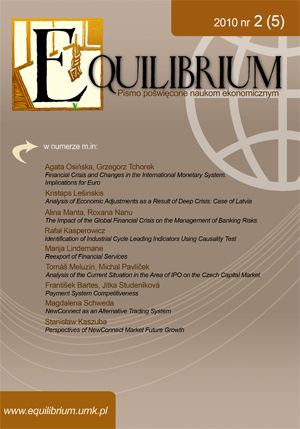Identification of industrial cycle leading indicators using causality test
DOI:
https://doi.org/10.12775/EQUIL.2010.024Keywords:
business cycle, industrial fluctuations, leading indicators, leading index, Granger causalityAbstract
The biggest business activity fluctuation analysts? attention is called to leading indicators. It is due to their utility in forecasting resulting form their properties. Leading indicators are aggregates describing a part of economy (e.g. sector, branch) and therefore also they partly anticipate new behaviours of all the economy. The first aim of the paper is to identify industrial business cycle leading indicators in Poland. The second aim is the estimation of a leading index of cyclical fluctuations of industry. When identifying the fluctuations, first one has to purify the time-series of incidental and seasonal fluctuations. According to that the time-series underwent adjustment procedure Census X11 and Hodrick-Prescott?s filter. These way cyclical fluctuations of time series were obtained. Seeking variables determining leading indicators of reference variable was conducted on the basis of Granger causality analysis. Series selected in that way were used to create forecasting econometric model (leading index).
Downloads
References
Boehm E. A. (2001), The Contribution of Economic Indicator Analysis to Understanding and Forecasting Business Cycles, Melbourne Institute of Applied Economic and Social Research, Working Paper No. 17/01.
Boehm E. A., Summers P. M. (1999), Analyzing and Forecasting Business Cycles with the Aid of Economic Indicators, Melbourne Institute of Applied Economic and Social Research, Working Paper No. 18/99.
Charemza W., Deadman D. (1997), Nowa Ekonometria, PWE.
Cieślak M., Red. Nauk. (2001), Prognozowanie gospodarcze. Metody i zastosowanie, PWN.
Diedold F. X., Rudebusch G. D. (1989), Scoring the Leading Indicators, Journal of Business, Vol. 62, No. 3.
Evans M. K. (2003), Practical Business Forecasting, Blackwell Publishers.
Granger C. W. J. (2001a), Investigating Casual Relations by Econometric Models and Cross-Spectral Methods, (Econometrica, 37, 1969), w: E. Ghysels, N. R, Swanson, M. W. Watson, Essays in Econometrics, Collected Papers of Clive W. J. Granger, Volume II: Causality, Integration and Cointegration, and Long Memory, Cambridge University Press.
Granger C. W. J. (2001b), Testing for Causality: A Personal Viewpoint, (Journal of Economic Dynamics and Control, 2, 1980 ), w: E. Ghysels, N. R, Swanson, M. W. Watson, Essays in Econometrics, Collected Papers of Clive W. J. Granger, Volume II: Causality, Integration and Cointegration, and Long Memory, Cambridge University Press.
Hendry D. F., Mizon G. E. (1999), The Pervasiveness of Granger Causality in Econometrics, w: R. F. Engle, H. White, Cointegration, Causality, and Forecasting. A Festschrift in Honour of Clive W. J. Granger, Oxford University Press.
Klein P. A., Moore G. H. (1982), The Leading Indicator Approach to Economic Forecasting ? Retrospect and Prospect, NBER Working Paper No. 941.
Kruszka M. (2002), Wyodrębnianie wahań cyklicznych, maszynopis powielony, AE Poznań.
Kydland F. E., Prescott E. C. (1990), Business Cycles: Real Facts and Monetary Myth, Federal Reserve Bank of Mineapolis Quarterly Reviev.
Lucas Jr. R. E. (1995)., Understanding Business Cycles, in F. E. Kydland (ed), Business CycleTheory, The International Library of Critical Writings in Economics, Edward Elgar Publishing Company.
Marcellino M. (2004), Leading Indicators: What Have We Learned?, IEP-Bocconi University, IGIER and CEPR.
McGuckin R. H., Ozyildrim A., Zarnowitz V. (2001), The Composite Index of Leading Economic Indicators: How to Make It More Timely, NBER Working Paper No. 8430.
Rekowski M., Red. Nauk. (2003), Wskaźniki wyprzedzające jako metoda prognozowania koniunktury w Polsce, Akademia Ekonomiczna w Poznaniu.
Vaccara B. N., Zarnowitz V. (1978), Forecasting with the Index of Leading Indicators, University of Chicago and NBER, Working Paper No. 244.
Zarnowitz V., Boschan Ch. (1975), Cyclical Indicators: An Evaluation and New Leading Indexes, Progress Report.






